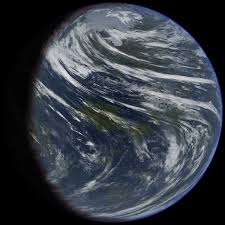- Home
- Your Views
- The Really Old Solar System
The Really Old Solar System
by Dylan
(Chicago, Illinois, USA)

Watery, Cloudy Venus
Astronomers engaged in the search for life in our galaxy frequently bring up “the habitable zone”, the not-too-hot-not-too-cold region of a star system wherein liquid water may flow upon a planet’s surface. Earth lies inside Sol’s habitable zone, of course, but our little blue ball isn’t the only world with that distinction. Alien astronomers from, say, Tau Ceti, might look upon Venus and Mars as potentially life-bearing as well, as they fall within the edges of Sol’s habitable zone.
Those theoretical stargazers might be right, too: Venus may harbor life in its clouds, and Mars in its newly-discovered aquifers. But, even if life were discovered on both planets, it would remain a far cry from the profusion of complex organisms that swarm over the surface of our lovely world. Earth has something the others lack: an atmosphere capable of housing the nectar of life, H20, in its liquid form. However, some astronomers believe this was not always the case! What’s more, the picture they paint resembles our beloved OSS in some surprising ways.
We’ll begin with Mercury - and then move on immediately. That poor little world has always been bone-dry, it seems. I imagine it comes with the sun-side view.
Venus is more exciting. Today, it resembles nothing less than Dante’s Inferno, coated in basalt and lava flats, with a crushing atmosphere of sulfuric acid and temperatures hot enough to make lead run like water. However, a recent study submitted to the Geophysical Research Letter suggests that as recently as 715 million years ago, a geological blink, Venus may have been as soggy as Earth. Venus would have been caught in the same Late Heavy Bombardment that gave Earth its water, providing it with at least a shallow ocean (for this study, researchers estimated about 525 meters deep). The planet’s proximity to Sol would mean that the oceans would immediately begin to evaporate, especially as the long Venusian day lasts about 243 Earth days. This would actually cool the planet, according to the study, as the steam formed a thick cloud layer that would reflect most of the incoming solar energy and possibly leave the planet slightly cooler than Earth.
A thick Venusian cloud layer- my, that sounds familiar!
We’ll be skipping again, this time right past Earth. We all know how that turned out.
Onward- to Mars! My favorite planet has also been the world’s, and as a result, has received the most attention from astronomers. The “Mars ocean hypothesis” has been under debate since the 80’s, but in essence, it postulates that the Vastitas Borealis basin in the northern Martian hemisphere was once full of water. This theory came to life when astronomers noticed that the basin is unusually flat, and that it is surrounded by what appear to be ancient shorelines. Also apparent on Mars are dozens of networks that look like dry riverbeds. These networks are largest near the equator and appear only in the southern hemisphere, supporting the notion of a large northern sea. What’s more, the “deltas” of these ancient networks line up with the proposed shoreline. As Mars would have been caught in the same bombardment as Earth and Venus, there is every reason to believe it had water, at least at one point.
This ocean would have covered about 19% of Mars’ surface, and been more than a mile deep. The early Martian atmosphere would have helped the planet retain it, being composed of heat-trapping carbon dioxide, and being about as thick as our current atmosphere. But that was also the rub: Mars could only keep its lovely ocean as long as it held onto its atmosphere. Having about half of Earth’s diameter, Mars had a harder time hanging onto its upper atmosphere, meaning that the sun and any meteorites that happened to come along would blast some of it away. The more air it lost, the more meteorites made it to the surface, and so things got worse. The atmosphere also bonded with the soil, giving Mars its famous red color and making the air still thinner. All this likely began about 4.2 to 3.7 billion years ago, about when life was getting its start on Earth. Since then, the air on Mars has been slowly seeping away, leaving us with the barren (if beautiful) planet we see today.
A slowly dying Mars? Where have I heard that before?
Now we skip a final time, through the asteroid belt, to Jupiter. That earliest and largest of planets would have acquired its system of moons as it was forming, but with a vital difference. Early Jupiter was hot, much hotter than it is today, although exactly how hot I’ve been unable to ascertain. (I would like some help with this. Does anyone know how warm the early Jovian system was?) A warm Jupiter might make the climates on Ganymede, Europa, Callisto and Io more pleasant, although Jupiter’s massive radiation belts would remain an issue.
Whether or not life existed on any of the other planets is another matter, and one scientists are still looking into. But the conditions were there, and much in the same manner as they appear in the OSS. Its funny how real life and fiction match up sometimes.
{Note from Zendexor: One great, vital, unanswered question is: how long does it take for life to appear and to develop, when conditions are suitable? The really young solar system (RYSS) - e.g. during its first half-billion years or so - was a place where just about anything could have happened, provided it happened fast enough. Since we have only one sample (Earth) to theorize from, the jury is still very much out!}
Comments for The Really Old Solar System
|
||
|
||


































